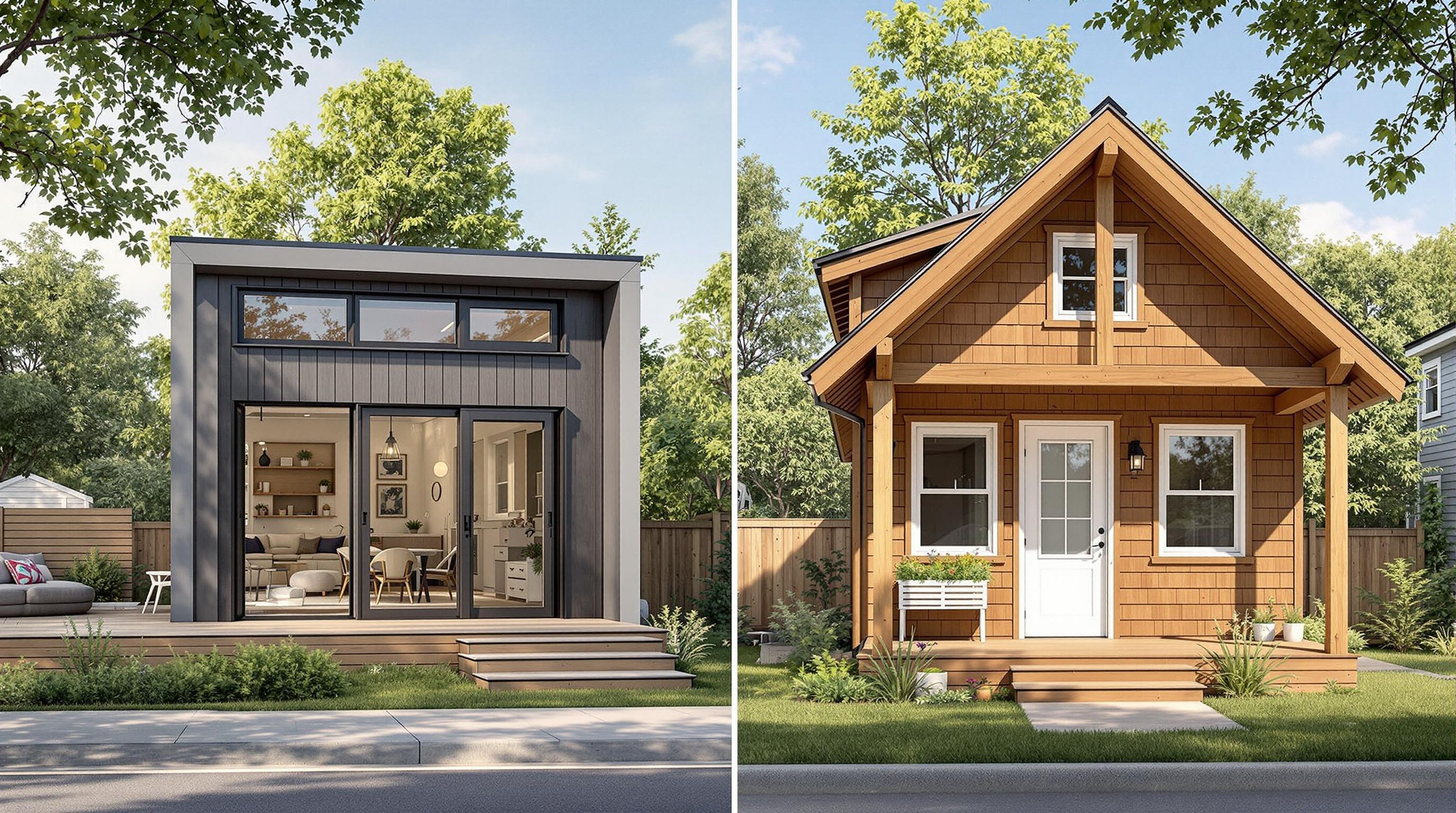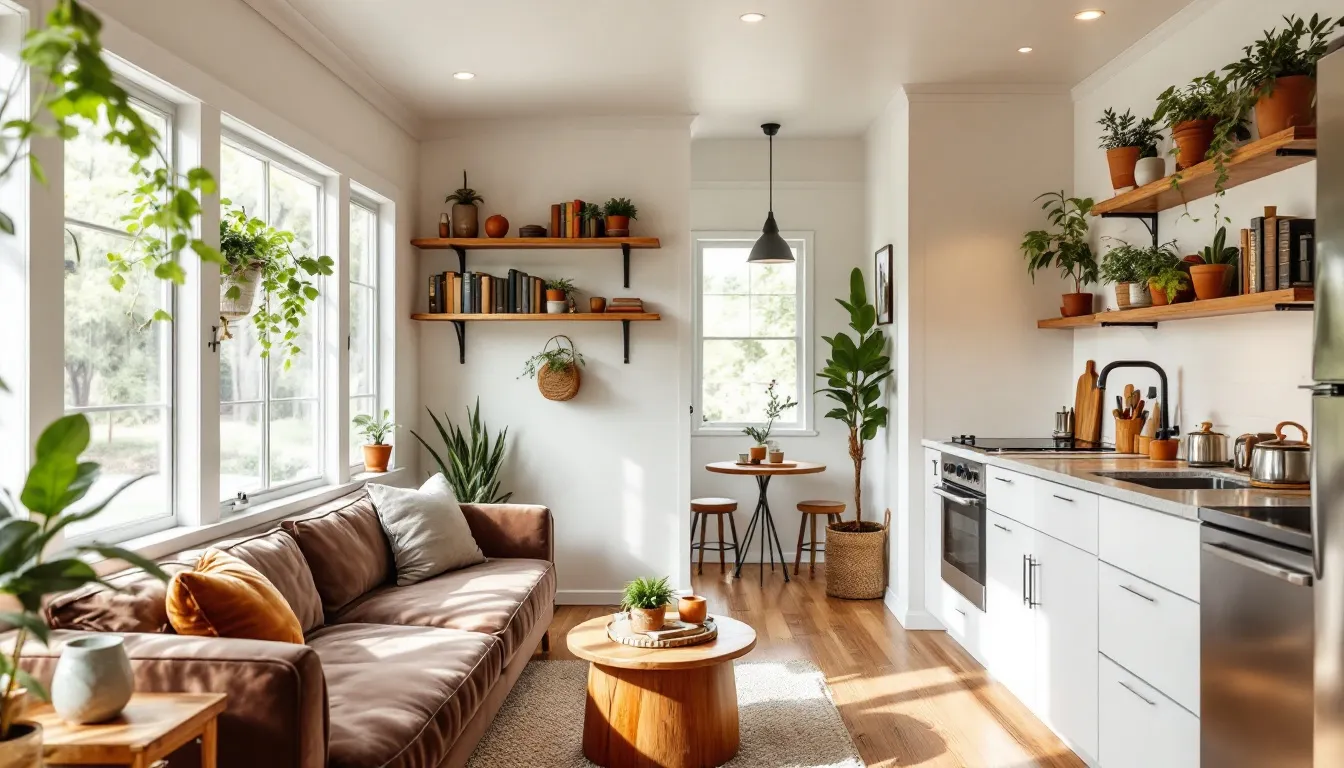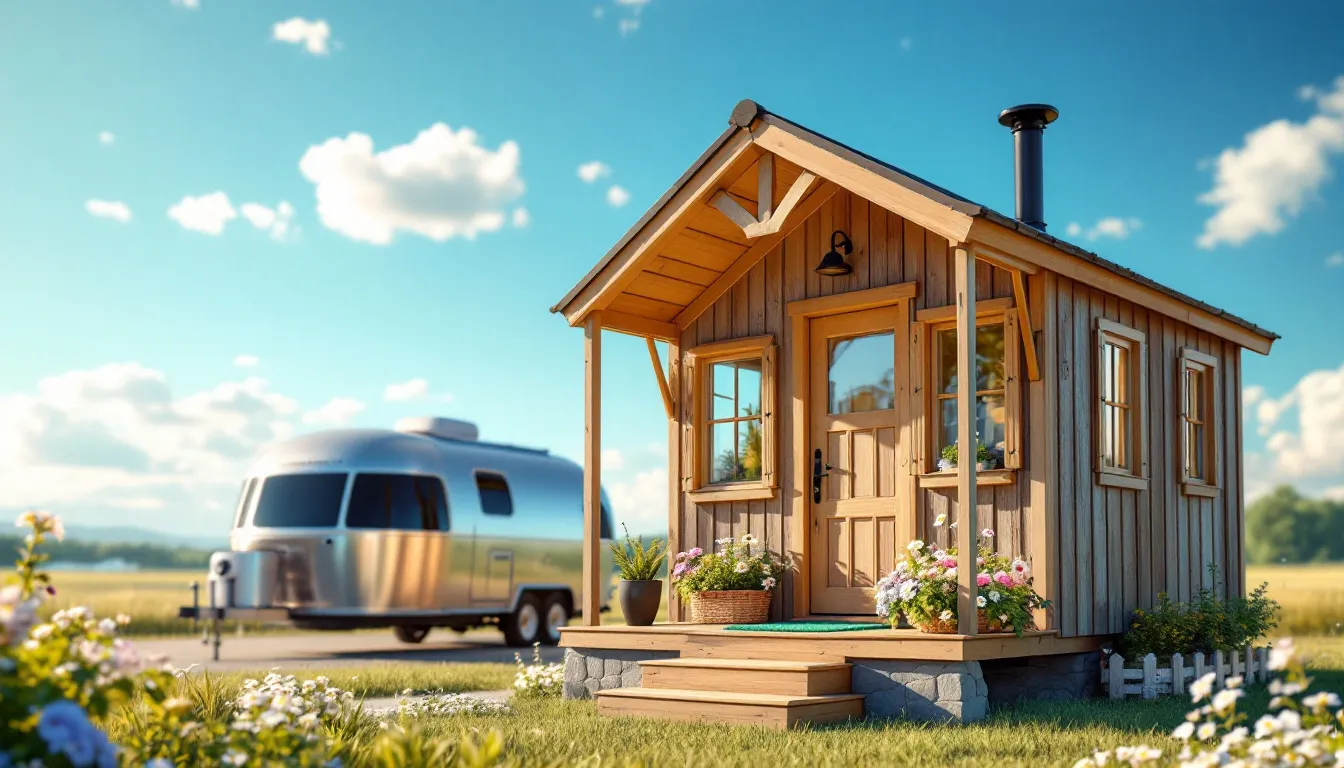- Frames: Choose steel for durability, Thermowood for eco-friendliness, or reclaimed wood for affordability and character.
- Siding: Metal siding is low-maintenance, while wood siding offers a natural look but needs upkeep.
- Insulation: Go for SIPs or foam boards for energy efficiency and moisture resistance.
- Roofing: Metal roofs are durable and cost-effective for tiny homes.
Prefabrication speeds up construction by 50%, reduces waste, and ensures consistent quality. Pair smart material choices with airtight construction and multi-layer insulation for a sustainable, energy-efficient home.
| Material Type | Benefits | Considerations |
|---|---|---|
| Steel Frame | Strong, pest/weather-resistant | Higher upfront cost |
| Thermowood Frame | Long-lasting, eco-friendly | Costs more than untreated wood |
| Reclaimed Wood | Sustainable, unique look | Requires more maintenance |
| SIP Insulation | High thermal performance, moisture-proof | Pricier than alternatives |
Start building smarter today with eco-conscious materials and modern techniques.
Lego-Style Hemp Blocks: A Sustainable Building Solution
Key Materials Used in Modular Tiny Houses
Choosing the right materials is key to building a durable and efficient modular tiny house. Here's a breakdown of the main components that make these homes sturdy and functional.
Structural Materials for the Frame
The frame forms the backbone of any modular tiny house, and the choice of material can impact durability, maintenance, and cost. Steel frames, for instance, are known for their strength and resistance to weather and pests. While they cost more initially, they require little upkeep. On the other hand, thermally treated wood, such as Thermowood, offers a long lifespan and aligns with environmentally conscious building practices. Reclaimed wood is another option, providing a sustainable and cost-effective choice with a unique aesthetic, though it may need more maintenance over time.
| Frame Material | Advantages | Considerations |
|---|---|---|
| Steel | Weather-resistant, pest-proof, low upkeep | Higher upfront cost |
| Thermowood | Long-lasting, eco-friendly, chemical-free | Costs more than untreated wood |
| Reclaimed Wood | Sustainable, unique look, affordable | Requires more frequent maintenance |
Once the frame is ready, the next step is selecting siding to protect the home and improve energy efficiency.
Exterior Siding Options
The siding on a modular tiny house needs to combine durability with energy efficiency. Metal siding is a popular choice due to its ability to withstand harsh weather and its low maintenance needs. While it may lack the charm of traditional materials, its practicality makes it a favorite for modular designs.
Aluminum siding, in particular, offers excellent protection while keeping the structure lightweight - especially important for mobile tiny houses. If you're after a natural look, wood siding like Lunawood's treated options can deliver both style and functionality. However, wood siding typically requires more upkeep.
Insulation Choices for Better Energy Use
Insulation is critical for maintaining comfort and minimizing energy use in modular tiny houses. Advanced materials like prefabricated SIPs (Structural Insulated Panels) and foam boards are excellent choices. These materials enhance energy efficiency, reduce thermal bridging, and resist moisture. Foam boards, though effective, tend to be pricier.
Windows also play a role in insulation. Double-pane glass is a smart choice, offering strong thermal insulation while letting in natural light - a must for compact living spaces.
sbb-itb-2ef3f3a
Modern Building Methods for Modular Tiny Houses
New techniques in modular construction are speeding up the building process and promoting eco-friendly practices. By using advanced materials and thoughtful methods, these homes offer efficient and sustainable living options.
Benefits of Prefabricated Construction
Prefabrication cuts construction time in half, reduces material waste, and ensures consistent quality through factory-based assembly. Working in a controlled environment allows for precision that’s often hard to achieve on-site.
| Benefit | Impact | Outcome |
|---|---|---|
| Quality Control | Built in a controlled setting | Fewer errors during assembly |
| Time Efficiency | 50% faster construction | Lower labor costs |
| Waste Reduction | Precisely cut materials | Less waste generated |
| Indoor Construction | Protected from weather | Reliable build quality |
For example, Häuslein's Luna Tiny House showcases how prefabrication and eco-conscious materials can result in a sturdy, environmentally friendly home [2].
Energy-Saving Techniques
Structural Insulated Panels (SIPs) are a key feature for boosting energy efficiency. They help reduce thermal bridging, making them an excellent choice for modular tiny homes.
Airtight construction further prevents energy loss by focusing on:
- Properly sealing windows and doors
- Using interlocking SIPs
- Applying moisture barriers
Multi-layered insulation strategies also play a major role. For instance, polyisocyanurate foam board insulation offers high R-values while resisting moisture [4]. Together, these methods create well-insulated spaces that need less energy for heating or cooling.
Finding Resources for Modular Tiny Houses
Finding the right resources is key to sourcing the materials you need and building your modular tiny house successfully. With the rise of the tiny house movement, several online platforms now connect builders, suppliers, and enthusiasts.
Tiny Houses For Sale, Rent, and More

TinyHouseSearch.com is a go-to platform for builders. It offers DIY kits, zoning advice, access to verified contractors, and material comparisons. You can find eco-conscious materials like reclaimed wood, bamboo flooring, and recycled metal roofing - perfect for balancing quality and environmental care.
When choosing suppliers, focus on details like certifications, customer reviews, and product specifications. These factors will help you select materials that suit your design and sustainability goals.
Conclusion: Choosing the Right Materials for Modular Tiny Houses
Key Takeaways
The materials you choose for modular tiny houses play a big role in both construction quality and long-term comfort. Modern options emphasize strength, eco-friendliness, and affordability.
Steel framing is a great example, offering durability and being highly recyclable [1]. Lunawood Thermowood is another standout, lasting up to 30 years with a carbon footprint of just 117 kg CO2 eq/m3 [2].
| Material Type | Benefits |
|---|---|
| Steel Frame | Strong, lightweight, recyclable |
| Lumber Frame | Classic, easy to work with |
| Metal Roofing | Weatherproof, built to last |
| Siding | Versatile, adds protection |
Energy efficiency is another priority. Materials like SIP panels and foam board insulation provide excellent thermal performance while keeping structures lightweight [4]. Prefabricated construction further boosts efficiency by minimizing waste, improving quality, and reducing labor costs [3].
When paired with eco-friendly materials like bamboo flooring and cork wall coverings, these methods create homes that are both practical and environmentally conscious. Choosing the right materials ensures your tiny house is built to last while being cost-effective and sustainable.



